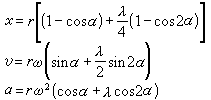1) racemization kinetics


消旋动力学
2) racemic kinetic resolution


消旋动力学拆开
3) spiral wave dynamics


旋波动力学
1.
Objective: To study the spiral wave dynamics in controlling ventricular fibrillation.


方法:利用旋波动力学的研究方法,对二维心脏系统施加周期驱动与有效驱动数值模拟心室颤动的控制和消除。
4) Gyrokinetics


回旋动力学
5) rotating dynamics


旋转动力学
1.
Based on rotating dynamics theory for computational creativity, thought inertia space model is proposed, including its constructing methods and properties, which posits that creativity can be reached through topology extension of thought inertia space by using inventive techniques such as substance field analysis, transformation creativity and combination creativity, etc.
根据思维的旋转动力学理论提出了思维惯性空间模型,包括惯性空间的构造及其性质,指出了创造就是通过物场分析、转换创造、组合创造等发明方法实现对惯性空间的拓扑扩展。
2.
Based on dialectics thinking and psychology theory, rotating dynamics is a newly created framework for computational creativity using differential topology.
旋转动力学理论是以辨证逻辑和心理学理论为指导 ,微分拓扑为工具建立起来的创新计算的统一理论框架 。
3.
, rotating dynamics provides an unifying framework for computational creativity by employing differential topology.
旋转动力学理论是以辨证思维和心理学理论为指导 ,微分拓扑为工具建立起来的创新计算的统一理论框架 。
6) vortex dynamics


涡旋动力学
1.
The hypothesis of vortex dynamics is proposed for explaining the peculiarities of excess heat and anomalous nucleus phenomena in .
提出了涡旋动力学理论解释电化学放电过程中的异常现象———过剩热和非平衡系统中的异常核现象。
2.
Since the discovery of high-Tc superconductors, vortex dynamics, which is an important key to understand superconductivity, becomes a central problem, and especially the time-dependent Ginzburg-Landau (TDGL) model that describes the dynamical properties of superconductors has been a subject of theoretical and experimental work.
自从高温超导体发现以来,涡旋动力学成为研究的中心问题,因为它是理解超导电性的重要关键之一。
3.
The hypothesis of vortex dynamics is proposed for explaining the peculiarities of excess heat and anomalous nucleus phenomena in the non-equ.
提出了涡旋动力学理论解释电化学放电过程中的异常现象——过剩热和非平衡系统中的异常核现象。
补充资料:动力机械:内燃机动力学
研究内燃机运转中的力学现象的科学。其主要任务是研究分析内燃机运转时各主要零件的运动规律及其受力情况﹐用以作为内燃机零件设计﹑计算的依据。它还研究这些力对内燃机动力装置的影响及其消减方法。内燃机动力学的主要内容为曲柄连杆机构运动学﹑曲柄连杆机构动力学和内燃机平衡分析等。
曲柄连杆机构运动学 研究曲柄﹑连杆﹐尤其是活塞的运动规律。活塞作周期性往复运动时的位移 、速度
、速度 和加速度
和加速度 可用下述各式近似求算
可用下述各式近似求算

式中 为曲轴转角﹔
为曲轴转角﹔  为曲轴旋转角速度﹔
为曲轴旋转角速度﹔ 为曲柄半径﹔
为曲柄半径﹔ 为曲柄半径
为曲柄半径 与连杆长度
与连杆长度 之比﹐即
之比﹐即  =
=  /
/ 
曲柄作回转运动﹐连杆作复杂的平面运动。连杆的运动往往被简化分解为随活塞组的往复运动和随同曲柄的旋转运动。
曲柄连杆机构动力学 研究分析曲柄连杆机构(见曲柄滑块机构)在运动中力的生成﹑传递和输出。作用在曲柄连杆机构上的力有曲柄连杆机构运动时产生的往复惯性力和离心惯性力﹐以及内燃机气缸内的气体压力。
说明:补充资料仅用于学习参考,请勿用于其它任何用途。
参考词条